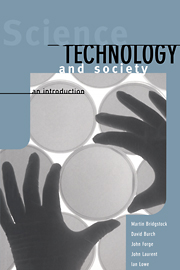Book contents
- Frontmatter
- Contents
- List of Figures
- List of Tables
- List of Contributors
- Preface
- Part One Scientific and Technological Communities
- Part Two Scientists and Technologists in the Wider Society
- 6 The Industrial Revolution in Great Britain
- 7 Science, Technology and the Economy
- 8 Science, Technology and Economic Theory
- 9 Science, Technology and Public Policy
- 10 Science, Technology and the Less-developed Countries
- 11 Science, Technology and the Future
- Appendix 1 Surviving in the Information Jungle
- Appendix 2 Referencing
- Index
6 - The Industrial Revolution in Great Britain
Published online by Cambridge University Press: 04 February 2010
- Frontmatter
- Contents
- List of Figures
- List of Tables
- List of Contributors
- Preface
- Part One Scientific and Technological Communities
- Part Two Scientists and Technologists in the Wider Society
- 6 The Industrial Revolution in Great Britain
- 7 Science, Technology and the Economy
- 8 Science, Technology and Economic Theory
- 9 Science, Technology and Public Policy
- 10 Science, Technology and the Less-developed Countries
- 11 Science, Technology and the Future
- Appendix 1 Surviving in the Information Jungle
- Appendix 2 Referencing
- Index
Summary
These improvements [in production] constitute the Industrial Revolution. They yielded an unprecedented increase in man's productivity and, with it, a substantial rise in income per head. Moreover, this rapid rise was self-sustaining.
[Landes 1969:41]What distinguishes the world since the Industrial Revolution from the world before is the systematic, regular and progressive application of science and technology to the production of goods and services.
[Rostow 1971:26]In Chapter 1 we said that technology is the means we use to change and exploit our surroundings. This is done because it is believed that these changes are for the better: that it is better to have a city here, a coal mine there, and so forth. (We make no judgement here about whether it really is better to have the coal mine, etc.) While Homo sapiens has always had technology, use has not always been on a large scale and hence has not always produced economic growth. It seems that the condition for the large-scale use of technologies is that the society in question is, or has been, industrial. (The qualification is needed because some highly technological societies are now termed post-industrial: they are no longer properly called industrial, but they were industrial at some time.) Thus, the process by which a society becomes industrialised is relevant to our overall purposes because it has to do with the optimal conditions for the application of technology.
- Type
- Chapter
- Information
- Science, Technology and SocietyAn Introduction, pp. 111 - 131Publisher: Cambridge University PressPrint publication year: 1998

